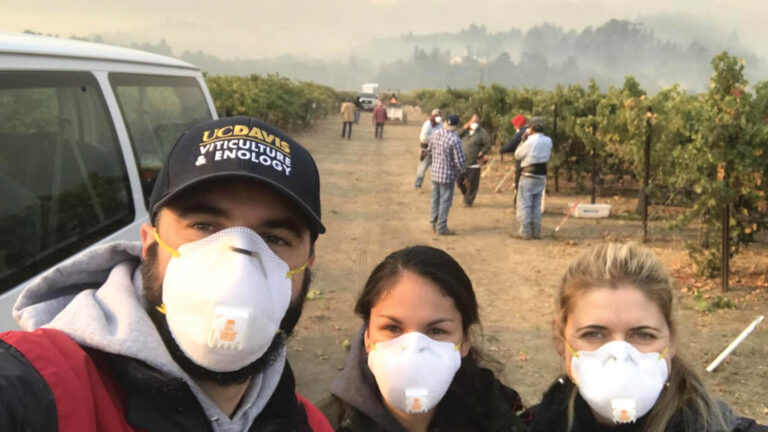
Wildfire Woes
Story by Aja Goare
As the wine swirls around the glass, long legs — as they’re called — streaking down the interior wall, aromas of green pepper, chocolate or perhaps clove may lay claim in the nose. But one scent that’s becoming ever more common in the wines of a fire-stricken state is smoke.
While some wines are meant to have a smoky quality to them, the presence of what’s known to researchers as “smoke taint” is a different matter. This quality occurs when smoke particles from wildfires deposit on grapes, UC Davis Professor of Extension Anita Oberholster explains. “Smoke is not as impactful to other crops — grapes are like mini sponges that absorb things from the atmosphere. The porous skin of the grape makes it very susceptible to absorbing smoke,” she says. A 2022 study from the Journal of Natural Products concurred, “Grapes and their vines physically survive wildfires, but the full impact from smoke and ash remains hard to assess.”
California saw over 7,095 wildfires with more than 360,000 acres burned in 2022. The shocking part? That count was remarkably lower than the state’s five-year average. When wildfires break out, the smoke produced by the blaze can carry more than 100 miles from the fire origin. So even though San Luis Obispo County doesn’t typically see the frequency of wildfires experienced other places in the state, smoke from surrounding areas still poses a threat to local grapes.

“In 2020, the impact was huge,” says Anita, who has been studying the impacts of smoke taint for over five years. “Lake Mendocino, Sonoma, Napa Counties [were] very impacted. The Central Valley, San Joaquin Valley, North and Central Coast were impacted. If you have five days of contact of smoke on skin then you will get that flavor in your wine.”
And that flavor may not come across as expected. It could taste like BBQ bacon, a diesel chemical smell, petroleum, medicinal bandage smell or other unsavory flavors. A smoke-tainted harvest could cost a vineyard owner tens of thousands of dollars, not just in lost product and sales but in labor costs as well. Sure, there’s crop insurance but not all policies are robust enough to cover the entire loss. To file a claim also requires testing, which Anita says can run $150–$400 per sample. “And insurance agencies want you to test every block of every variety,” she says.

So what’s the wine industry to do? The path forward is unclear. That’s because testing on the issue has been extremely limited in the U.S. and proposed solutions are flawed.
“On the vineyard side, we’re looking at edible barrier sprays. They seem to absorb the phenols so it doesn’t go into the grape,” shares Anita. “When you’re spraying in the field, you can’t get 100 percent coverage. It’s difficult to wash grapes and takes a lot of water that we don’t have.”
There’s also the possibility of using reverse osmosis to remove volatile phenols from the wine, but that process can unintentionally remove other desirable qualities from the wine, too. “We’re trying to develop optimized resins that only target bad compounds and nothing else,” she says.
Researchers like Anita and those from UC Santa Cruz believe more testing and time are needed to determine the best, most cost-effective solution. Failure to more closely examine this issue, especially as disastrous wildfires become the norm in California, could harm business relationships and impact production.
“Contracts between wineries and growers have vague quality phrases like, ‘If the grape is not the quality expected, I may reject it,’” says Anita. “The problem is because they’re naturally present in grapes, we need to know the baseline but that has not been determined in California. We would need three to five seasons for robust data to determine what’s normal versus abnormal.”
In the meantime, the improvement and expansion of crop censors may help vineyard owners better understand when the threat of smoke taint is high enough to warrant costly testing. This can help reduce the extensive backlog and delays that arise during fire season. While researchers explore how and when a grape is most impacted, as well as different prevention techniques, Anita urges consumers to have faith in their winemakers.
“The phenols that impact the grapes cannot be seen with the naked eye. About 25 percent of people aren’t even able to recognize [the smoke]; perhaps they don’t have the enzyme to taste it,” argues Anita. “To consumers, I’d say no winemaker wants to put a tainted wine on the shelf. Just because you see smoke in the air doesn’t mean it will smoke out the wine.“

